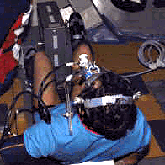Exercising In Space
 What did astronaut Shannon Lucid like least about her six months on Space Station Mir? The daily exercise. 'It was just downright hard,' she wrote in Scientific American (May 1998). 'I had to put on a harness and then connect it with bungee cords to a treadmill.' The harness and cords kept her feet on the treadmill. They also provided resistance for her muscles to work against. As Shannon learned, ordinary Earth-style exercises are useless in space. Lifting weights is impossible. A barbell floats like a feather. Crunches are easy but worthless, because the muscles of the abdomen have no upper body weight to lift. Walking and running require little effort, so they can't build muscle strength or maintain the health of heart and blood vessels.
What did astronaut Shannon Lucid like least about her six months on Space Station Mir? The daily exercise. 'It was just downright hard,' she wrote in Scientific American (May 1998). 'I had to put on a harness and then connect it with bungee cords to a treadmill.' The harness and cords kept her feet on the treadmill. They also provided resistance for her muscles to work against. As Shannon learned, ordinary Earth-style exercises are useless in space. Lifting weights is impossible. A barbell floats like a feather. Crunches are easy but worthless, because the muscles of the abdomen have no upper body weight to lift. Walking and running require little effort, so they can't build muscle strength or maintain the health of heart and blood vessels.
Space travelers experience many other changes in their bodies. One of the first and most noticeable is shrinking of the legs and swelling of the face, as fluids--freed from gravity's pull--redistribute more evenly throughout the body tissues. Each leg loses about a liter of water in the first day, and the legs remain smaller throughout the space flight. The collection of fluid in the head produces a perpetual case of 'space sniffles' that abates only during strenuous exercise. The redistribution of fluid has effects that are more serious, one of which is a form of anemia unique to space travelers. The loss of fluid from the bloodstream to the tissues creates an overabundance of red blood cells. In response, the body produces fewer and destroys more. Astronauts feel the loss when they return to Earth and must work against gravity again.
Exercise is essential to the health and well-being of women and men working in space. Research has shown that astronauts lose bone and muscle mass during their flights. The loss of bone raises calcium levels in the blood, which may lead to kidney stones. NASA planners think resistance exercise using elastic bands should reduce such effects, but whether they can be prevented entirely is unknown. Our experience so far in space shows that all body systems except the skeletal and muscular return to normal after astronauts return to Earth. So far, evidence suggests that human beings can live and work safely in space for long periods, but so far 'long' had meant 'months.' How might humans cope with trips to the other planets that require several years? No one knows.
About the Author
Faith Brynie, Ph D
 Faith Brynie holds a B.A. in Biology from West Virginia University and an M.A. and Ph.D in science curriculum and instruction from the University of Colorado. She writes books and articles on science and health topics for children, teens, and non-scientist adults. Some of her books have won awards, including two 'Best Book of the Year' citations from the American Association for the Advancement of Science.
Faith Brynie holds a B.A. in Biology from West Virginia University and an M.A. and Ph.D in science curriculum and instruction from the University of Colorado. She writes books and articles on science and health topics for children, teens, and non-scientist adults. Some of her books have won awards, including two 'Best Book of the Year' citations from the American Association for the Advancement of Science.


